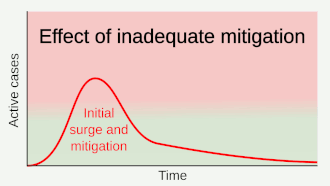

Part of managing an infectious disease outbreak is trying to delay and decrease the epidemic peak, known as flattening the epidemic curve.[1] This decreases the risk of health services being overwhelmed and provides more time for vaccines and treatments to be developed.[1] Non-pharmaceutical interventions that may manage the outbreak include personal preventive measures such as hand hygiene, wearing face masks, and self-quarantine; community measures aimed at physical distancing such as closing schools and cancelling mass gathering events; community engagement to encourage acceptance and participation in such interventions; as well as environmental measures such surface cleaning.[5] It has also been suggested that improving ventilation and managing exposure duration can reduce transmission.[6][7]
During early outbreaks, speed and scale were considered key to mitigation of COVID-19, due to the fat-tailed nature of pandemic risk and the exponential growth of COVID-19 infections.[8] For mitigation to be effective, (a) chains of transmission must be broken as quickly as possible through screening and containment, (b) health care must be available to provide for the needs of those infected, and (c) contingencies must be in place to allow for effective rollout of (a) and (b).[citation needed]
By May 2023, in most countries restrictions had been lifted and everyday life had returned to how it was before the pandemic due to improvement in the pandemic's situation.[9][10]
| Part of a series on the |
| COVID-19 pandemic |
|---|
 |
|
|
|
- ^ a b c d Anderson RM, Heesterbeek H, Klinkenberg D, Hollingsworth TD (March 2020). "How will country-based mitigation measures influence the course of the COVID-19 epidemic?". Lancet. 395 (10228): 931–934. doi:10.1016/S0140-6736(20)30567-5. PMC 7158572. PMID 32164834.
A key issue for epidemiologists is helping policy makers decide the main objectives of mitigation—e.g. minimising morbidity and associated mortality, avoiding an epidemic peak that overwhelms health-care services, keeping the effects on the economy within manageable levels, and flattening the epidemic curve to wait for vaccine development and manufacture on scale and antiviral drug therapies.
- ^ Qualls N, Levitt A, Kanade N, Wright-Jegede N, Dopson S, Biggerstaff M, et al. (April 2017). "Community Mitigation Guidelines to Prevent Pandemic Influenza - United States, 2017". MMWR. Recommendations and Reports. 66 (1): 1–34. doi:10.15585/mmwr.rr6601a1. PMC 5837128. PMID 28426646.
- ^ Barclay E, Scott D, Animashaun C (2020-04-07). "The US doesn't just need to flatten the curve. It needs to "raise the line."". Vox. Archived from the original on 2020-04-07.
- ^ Wiles S (2020-03-14). "After 'Flatten the Curve', we must now 'Stop the Spread'. Here's what that means". The Spinoff. Archived from the original on 2020-03-26. Retrieved 2020-03-13.
- ^ "Community Mitigation Guidelines to Prevent Pandemic Influenza—United States, 2017". Recommendations and Reports. 66 (1). 2017-04-12.
- ^ Epperly DE, Rinehart KR, Caney DN (2020). "COVID-19 Aerosolized Viral Loads, Environment, Ventilation, Masks, Exposure Time, Severity, And Immune Response: A Pragmatic Guide Of Estimates". medRxiv 10.1101/2020.10.03.20206110.
- ^ "Viral Load Exposure Factors". ReallyCorrect.com.
- ^ Cirillo, Pasquale and Nassim Nicholas Taleb (2020). "Tail Risk of Contagious Diseases". Nature Physics. 16 (6): 606–613. arXiv:2004.08658. Bibcode:2020NatPh..16..606C. doi:10.1038/s41567-020-0921-x. S2CID 215828381.
- ^ "From emergency response to long-term COVID-19 disease management: sustaining gains made during the COVID-19 pandemic". www.who.int. World Health Organization. Retrieved 9 May 2023.
- ^ Heyward G, Silver M. "WHO ends global health emergency declaration for COVID-19". Retrieved 9 May 2023.